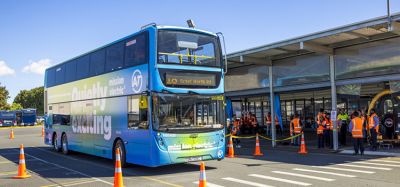Momentum ahead – CAM still set to progress in the UK in 2021
- Like
- Digg
- Del
- Tumblr
- VKontakte
- Buffer
- Love This
- Odnoklassniki
- Meneame
- Blogger
- Amazon
- Yahoo Mail
- Gmail
- AOL
- Newsvine
- HackerNews
- Evernote
- MySpace
- Mail.ru
- Viadeo
- Line
- Comments
- Yummly
- SMS
- Viber
- Telegram
- Subscribe
- Skype
- Facebook Messenger
- Kakao
- LiveJournal
- Yammer
- Edgar
- Fintel
- Mix
- Instapaper
- Copy Link
Posted: 19 January 2021 | Mark Cracknell | No comments yet
Mark Cracknell, Head of Technology at Zenzic, assesses the state of play in the UK’s connected and autonomous mobility (CAM) market and expresses optimism that 2021 could be a year filled with progress for the sector.


2020 proved to be a turbulent first year for progress towards realising the promise of connected and automated mobility (CAM) in the UK. The pandemic has radically changed the way we travel, unfortunately pushing people away from public transport, but despite the negative headlines, there are still many reasons to feel optimistic about the future of CAM.
2021 is going to be an important year for the development of various CAM technologies – self-driving vehicles in particular. A lot of the groundwork around regulation, legal and safety frameworks was laid last year, from which varied real-world, passenger-carrying trials of CAM services across the country can start to flourish. These trials will start to show how CAM can aid the UK’s recovery from the pandemic, and inspire local governments to think about how this new form of transport can bolster their public transport systems.
Our roadmap
As we were able to show in the CAM Creators Update to the UK Connected and Automated Mobility Roadmap to 2030, the UK is forging ahead with the development of key enabling technologies of Connected and Autonomous Vehicles (CAVs) in the fields of AI, cybersecurity, and software.
These developments set the country up to double down on research and push on towards deployment. We’ve spent a lot of time exploring self-driving technologies and their benefits, now is the time to plan out how we can benefit from them.
Multiple UK testbeds, such as Millbrook, Smart Mobility Living Lab (SMLL), and Midlands Future Mobility all launched their self-driving vehicle testing facilities last year, bolstering the range of facilities across the country and offering everything from controlled testing environments to fully connected public roads. These testbeds are playing host to partners from around the world and are in a great position to lead CAM innovation in the UK.
Looking to 2021 and the broader economic recovery of the UK, we are home to some of the world’s leading technology companies working on self-driving vehicles, from the likes of self-driving pod developer Aurrigo, to Five and Oxbotica who have run self-driving vehicle trials on British roads.
This all contributes to our strong track record of delivering trusted, world-class solutions across safety assurance, cyber security, simulation, and certification.
We need to ensure this nascent industry is nurtured so that the UK is able to benefit from the safe and secure deployment of technology, and to export opportunities for our technology and services as we maintain our global advantage.
Environmental benefits
The global scale of the pandemic, while devastating, has shown the dramatic effect a significant reduction in worldwide carbon emissions has on our environment. Recent reports have suggested that we used around 6 per cent less energy last year, the equivalent of the entire energy demand of India. Air quality has been a particular beneficiary.
Local authorities should look to start mapping out how CAM will integrate into their existing transport plans”
These positive environmental benefits which we have seen are something we should strive to sustain as lockdown lifts. They show the scale of the effect that changing transport habits can have on reducing carbon emissions. When we consider the government’s net-zero carbon emissions target for 2050, this is clearly a central piece of the puzzle.
This year, local authorities should look to start mapping out how CAM will integrate into their existing transport plans and work together to find common approaches. Public transport networks have been badly hit by falling passenger numbers, which complicates the path to more sustainable transportation. We need to rehabilitate public transport, but we should recognise the opportunity at a national and regional level to introduce CAM services and technologies which support low or zero-carbon emission travel in ways that fit with local needs.


London’s empty streets contributed to a rise in air quality as national lockdowns became the norm in 2020.
Practical examples going live in 2021
Examples of the possibilities of CAM are set to go live in 2021. CAVForth is an autonomous bus service which will soon be transporting paying passengers across the Forth bridge, offering flexible and efficient services. Meanwhile, the ServCity project will ferry passengers on public London roads in self-driving Nissan electric vehicles.
Aside from the environmental benefits, ongoing trials of connected and automated freight on UK motorways pave the way for improved vehicle-to-vehicle connectivity and more efficient use of our roads.
It is estimated that improved vehicle connectivity infrastructure could help save £400m a year as vehicles can react to traffic information in their area, resulting in a smoother flow of traffic, more reliable journeys and increased productivity. This is especially important given tight council budgets, and the increasing importance of home delivery for goods and groceries.
Clearly, the trials happening in 2021 should encourage all local authorities to think about CAV blueprints and how they fit into plans around sustainability, connectivity and mobility. It has been a difficult year for CAM, but that should by no means distract from the real progress which has been made, and the plans which are set to continue the UK’s leadership in the area.
Maintaining momentum
The events of 2020 have forced all industries to rethink their plans. In 2021, it is natural to expect a rebalancing of these aims. Lockdowns have shown us a tantalising glimpse of a low-carbon future, and have allowed us to take a step back from our existing public transport paradigm and imagine how it might be strengthened.
With trial schemes set to go live around the UK and testbeds playing host to world-leading companies, we need to continue to provide the investments in innovative companies, technology and research to ensure we maintain the UK’s position of leadership.
Biography
Mark joined Zenzic in 2018, and is now leading on the UK Connected and Automated Mobility Roadmap to 2030. he previously worked at TfL, supporting the London connected and automated testbed. Mark is also a chartered engineer has a first-class degree in Electrical and Electronic Engineering from Southbank University.
Related topics
Air Quality, Alternative Power, Artificial Intelligence, Connected & Autonomous Vehicles, COVID-19, Intelligent Transport Systems (ITS), Public Transport, Sustainable Urban Transport, Transport Governance & Policy
Related modes
Autonomous vehicles
Related cities
UK
Related organisations
Aurrigo, Five, Midlands Future Mobility, Millbrook, Oxbotica, Smart Mobility Living Lab (SMLL), Zenzic








